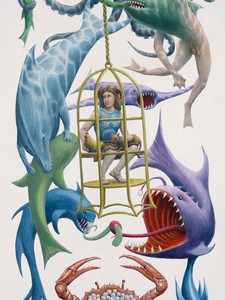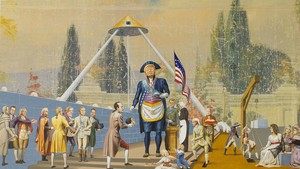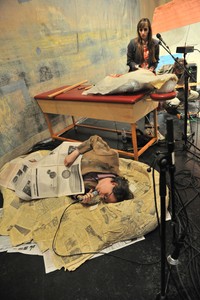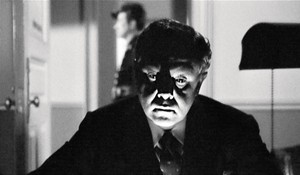
Jim Shaw: A–Z
Charlie Fox takes a whirlwind trip through the Jim Shaw universe, traveling along the letters of the alphabet.
I want there to be things in my work that people can access, but also hidden secrets.
—Jim Shaw
Over the past three decades, Jim Shaw has responded to American cultural history through painting, drawing, and sculpture. He has found inspiration in comic books, pulp novels, rock albums, protest posters, and amateur paintings; his ever-growing collection of found artworks has also been the subject of several exhibitions in its own right. Often unfolding in extended narrative cycles marked by repetition and cross-reference, Shaw’s works juxtapose images of friends and family with those depicting world events, pop-cultural phenomena, and alternative realities, blending the personal, the commonplace, and the visionary. Committed to undoing any sense of aesthetic or ideological purity, Shaw has turned consistently to his own life—particularly his unconscious mind—as a source of inspiration.
Shaw was born in 1952 in Midland, Michigan, and lives and works in Los Angeles. In 1971, he enrolled at the University of Michigan, Ann Arbor, where he met artist Mike Kelley. The pair would sometimes advertise fake lectures, treating attendees to “guerilla style” performances instead. In 1974, Shaw graduated from UM with a BFA and cofounded proto-punk band Destroy All Monsters (DAM) with filmmaker Cary Loren and artist Niagara. At the time, Shaw lived with Kelley in a house they named “God’s Oasis,” which served as the band’s rehearsal space. He later contributed to an eponymous zine, Destroy All Monsters Magazine, published by Loren between 1976 and 1979, that explored the mythology of DAM still further. In 1978, Shaw earned an MFA from California Institute of the Arts; he then worked in the film industry before gaining recognition as a visual artist in the mid-1980s.
In the late 1970s, Shaw drew inspiration from William Burroughs—who would become an ongoing influence—and his “cut-up” technique of textual collage to begin Distorted Faces, a series of portrait paintings and drawings in which the features of celebrities and politicians, friends and strangers are twisted into their monstrous doubles. His first major project, My Mirage (1986–91), was a more complex undertaking. A series of 170 images rendered in a variety of styles, it traces the adventures of a middle-class white boy named Billy—Shaw’s alter ego—as he experiences sex, drugs, rock and roll, and religion in 1960s and ’70s America. Another series, Dream Drawings (1992–99), presents uncanny scenes, derived from the artist’s own dream life, in a comic-strip format, while Dream Objects (1994–) manifests selected items from these nocturnal visions as unsettling, cartoonlike sculptures.
Shaw’s ongoing project Oism, which he initiated in the late 1990s, is an artistic attempt to create and promote a functioning religion, complete with its own history and symbolism, rituals and traditions. The enterprise reflects Shaw’s extensive research into the messianic cults active in the Bible Belt and has fueled a kaleidoscopic array of artworks-cum-artifacts. Having grown to include paintings, photographs, sculptures, collages, posters, films, and musical instruments, the accumulation has become even more sophisticated than was originally envisioned, incorporating historical context to arrive at a near-encyclopedic review of abolitionist, evangelical, spiritualist, and utopian currents in American culture.
In 1999, Shaw had his first major European retrospective at the Casino Luxembourg and Musée d’art moderne et contemporain, Geneva; the following year, Thrift Store Paintings opened at the Institute of Contemporary Arts, London, revealing entries from his frequently hilarious and horrifying collection of canvases by unknown amateur artists. In 2013, Chalet Society, Paris, presented The Hidden World, another display drawn from his personal archives that focused on “didactic art”—books, flyers, T-shirts, and other artifacts aimed at promoting various wildly eccentric belief systems. In 2015, a sprawling survey exhibition dubbed The End Is Here—its title reprising that of his MFA thesis exhibition at CalArts—opened at the New Museum, New York.

Charlie Fox takes a whirlwind trip through the Jim Shaw universe, traveling along the letters of the alphabet.

The Spring 2023 issue of Gagosian Quarterly is now available, featuring Roe Ethridge’s Two Kittens with Yarn Ball (2017–22) on its cover.

Catherine Taft examines Jim Shaw’s visionary work, which probes the American psyche through political, historical, and cultural allegory.

In this Shortlist series we invite artists and writers to tell us about works of art, literature, film, or music that have influenced their work or are at the forefront of their minds today. Here Jim Shaw shares a selection of songs he listens to while working, from new discoveries to childhood staples. Shaw writes of the balance between delight and regret, hope and gloom in his playlist.

In the fall of 2021, in partnership with New York’s Metrograph cinema and Gagosian, Jim Shaw organized a series of six conspiracy-minded films revolving around thorny questions of truth, guilt, fantasy, and innocence, and leading Shaw to revelations about the fringe notion of “frazzledrip.” Here, Natasha Stagg reflects on the movies he chose and on the wider implications of what it means to go down the rabbit hole.
Request more information about
Jim Shaw